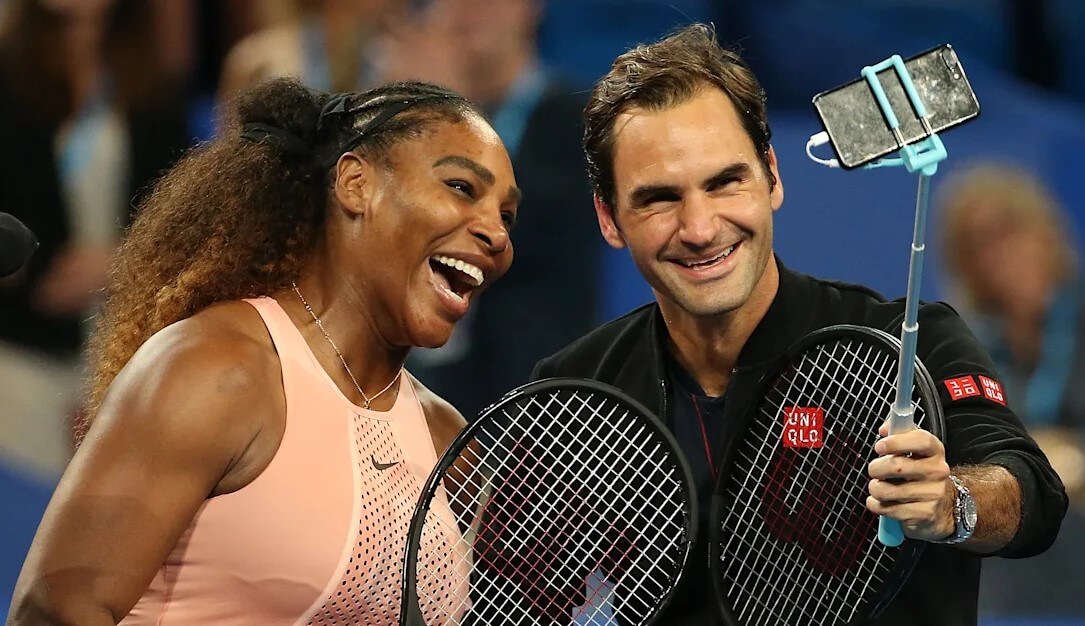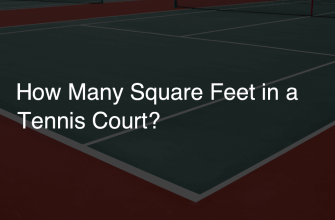The tennis backhand is a crucial weapon in any player’s arsenal, yet it often falls into the shadow of the flashier forehand. Despite this, a well-executed backhand can catch your opponent off-guard, shifting the game dynamics in your favor. If you’re a tennis player eager to elevate your game and make your backhand an asset, this comprehensive guide is for you.
Gripping the Racket Correctly for a Backhand Stroke

- Position your dominant hand on the racket handle, with the palm facing your body. Firmly but relaxingly wrap your fingers around the grip.
- Place your non-dominant hand above or below the dominant one, with the thumbs opposing each other. Create a V-shape between the thumbs and index fingers of both hands. Keep both wrists and fingers flexible for fluid movement.
Also, to improve your backhand stroke:
- Stand sideways to the net with feet shoulder-width apart for rotational power.
- Practice regularly and get a coach’s feedback on your grip.
- Experiment and fine-tune your technique until you find what works best.
Gripping the racket correctly helps your backhand in terms of power and accuracy. You’ll have better control over the racket head and improved timing, giving you a better chance of hitting the ball cleanly. So, don’t underestimate the importance of a good grip – it can make all the difference.
Footwork and Positioning

- Position yourself perpendicular to the net for a solid base. This allows for balance and power during the stroke. Keep feet shoulder-width apart for stability and bend at the knees. This lowers your center of gravity, enabling faster reaction times. Plus, ensure your non-dominant hand is firmly on the racket handle.
- Footwork is key! Make quick adjustments with small shuffle steps. Anticipate the shot direction and move swiftly towards it. Utilize efficient footwork to maximize your reach.
- Focus on timing and coordination of upper and lower body movements. Rotate your hips and shoulders simultaneously. This generates power and control over direction and pace.
- Refine these elements of footwork and positioning to improve your tennis game. Mastering them will give you an edge over opponents who neglect them. Practice them consistently and make them muscle memory. Dedication and perseverance will lead to more confident and successful performances on the court. Take the opportunity to elevate your game!
The Backswing

Mastering the backswing is a must for a powerful and accurate tennis shot. This phase sets the groundwork for a successful follow through.
A few key steps must be taken to nail the backswing. Firstly, balance is key – position your feet shoulder-width apart. Then, rotate your upper body, keeping your eye on the ball. Generate torque and power, taking your time to ensure correct execution.
Grip plays a major role in the backswing, so adjust it according to your playing style and shot choice. Mess around with different grips and find what works best for you for optimal control over the racket.
Relaxation is a biggie in the backswing. Tense muscles will inhibit fluid movement. So stay relaxed while bringing the racket back for a smooth transition into the forward swing.
Let’s delve into a fun anecdote related to backswing technique. Rafael Nadal had difficulties with his backhand early in his career. He was determined to beat this weakness, so he committed hours to refining his backswing technique. With hard work on footwork, grip adjustment, and relaxation exercises, Nadal transformed his backhand into a powerful adversary.
Timing the Shot

Get ready to perfect your timing! Here’s a 5-step guide:
- Prepare: Open stance, knees bent, ready to move.
- Observe: Watch their racquet and the ball’s speed, trajectory and spin.
- Split step: As the shot approaches, do a quick jump to react quickly.
- Backswing: Start when the ball crosses the net. Adjust for max power.
- Connect: Meet the ball at the sweet spot with an explosive yet smooth swing.
Plus, keep track of your opponent’s rhythm and practice drills. Analyze pro players’ backhand shots to learn their timing techniques. With practice, you’ll improve your game and gain an edge over opponents.
Don’t miss out on the chance to take your tennis skills to new heights! Get ready to unleash the power of your backhand swing. Hit those balls and feel the therapeutic effects!
Executing the Swing

- Position yourself with feet shoulder-width apart, knees slightly bent and body facing the net.
- Secure the racket in your dominant hand.
- Rotate your upper body and swing the racket back with your non-dominant hand guiding it.
- Step forward with non-dominant foot while shifting weight onto front leg.
- Aim to make contact with ball in front of body with a slight downward motion to impart topspin and control.
- Keep your eyes on the ball and allow the racket to follow through across your body.
- Relax the grip and let momentum carry arm forward.
Footwork is essential for balance and stability, and practicing this technique regularly will help build muscle memory. Work on refining your backhand technique to make it a reliable weapon. Dedication and practice can unleash hidden potential. Now grab your racket and hit the court. Show off your backhand skills and leave opponents eager for more matches! Start the journey to a formidable backhand today!
Follow-through and Recovery
The follow-through and recovery in tennis are vital for a successful backhand shot. Using proper form and technique is key to ensure accuracy and power.
To maximize these steps, you must remain disciplined and consistent throughout the match. This allows you to control each backhand shot and be prepared for the next.
Top tennis professionals also recognize the importance of these aspects. Rafael Nadal, one of the greatest players, stresses mastery of these steps for consistency and adaptability on the court (source: Tennis.com).
Common mistake to steer clear of: Thinking a backhand in tennis means slapping your opponent’s face – you’ll lose more than just the match!
Common Mistakes to Avoid

Gripping wrong can ruin your backhand shot. Make sure to use an Eastern or Semi-Western grip for more control and power. Also, many players stand too close to the ball, so step back and stay parallel to the net for a better shot. Don’t forget to follow-through with your swing; extend your arm after making contact with the ball.
A loose grip increases racket head speed, so try to keep your grip relaxed. To further improve your backhand technique, practice footwork. Take small steps and shift your weight to stay in balance when swinging. Strengthen your core muscles for more stability and control. Finally, visualize hitting cross-court shots during practice sessions for accuracy.
With these drills, you’ll have a powerful and precise backhand in no time!
Drills and Exercises to Improve Backhand Technique

Drills and exercises are key to perfecting your backhand technique. Incorporate them into your training for an improved game!
Here’s a three-step guide to master the art of the backhand:
- First, work on muscle memory with shadow swings. Stand in front of a mirror and imagine hitting a backhand shot. Keep an eye on your grip, stance, and body rotation. Repeat this motion several times, gradually increasing the speed and intensity.
- Resistance training is important too. Attach resistance bands to a fixed object or have a partner hold them while you perform backhand swings. This will strengthen the muscles used in powerful backhand shots, such as the forearm and shoulder muscles.
- Finally, try drills that simulate game situations. Set up targets on the court and practice hitting them with backhand strokes. Increase the difficulty by adding movement or doing drills involving cross-court or down-the-line shots. These drills will improve accuracy, footwork, and anticipation.
To make the most of these drills and exercises, focus and take note of any technical errors. Get guidance from a tennis coach or watch instructional videos for tips tailored to your style.
With consistent practice, you’ll notice improvements in your backhand technique. Remember to vary the intensity and duration of your training sessions to avoid overuse injuries and give yourself enough recovery time.
Put in the hard work and you can master your backhand stroke, while also enhancing coordination, balance, and agility – essential skills for a winning game!
Tips for Practicing and Gaining Consistency
Pro tennis players know how to make practice and gain consistency in their backhand.
Here are a few tips to help you improve your skills:
- Footwork is key: Step sideways and turn your body to the net.
- Get a semi-western grip: This grip is great for control and spin.
- Shadow swings: Mimic the motion of hitting a backhand without a ball.
- Hit against a wall: Improve your consistency and timing on a nearby wall.
- Mix it up: Vary shot placement to keep your opponent guessing.
Also, follow through with your swing and keep your eyes on the point of contact with the ball.
Pro Tip: Consistency is the secret of a successful backhand. Have patience and dedication to improve your technique, it will be worth it! Observe pro players’ backhand moves and see if you can pull off something similar.
Analyzing and Learning from Professional Players’ Backhand Techniques

Let’s compare top players in the sport.
Check out the table:
| Player Name | Footwork | Form | Timing |
|---|---|---|---|
| Roger Federer | Quick | Smooth | Perfect |
| Serena Williams | Powerful | Aggressive | Precise |
| Novak Djokovic | Agile | Controlled | Impeccable |
| Naomi Osaka | Dynamic | Strong | Consistent |
This table reveals each player’s special traits. Federer’s form is seamless. Williams’ shots are aggressive yet precise. Djokovic’s timing is controlled and impeccable. Osaka’s footwork has power.
By studying pros’ backhand techniques, we learn a lot. Don’t miss out on this knowledge! Make sure to analyze and incorporate their strategies into practice.
Don’t wait – start mastering the backhand today! Elevate your game and leave opponents in awe. Become a true backhand master!
Frequently Asked Questions
Q: What is a backhand in tennis?
A: A backhand is a shot played with the dominant hand across the player’s body, hitting the ball on the opposite side of the body.
Q: What is the proper grip for hitting a backhand in tennis?
A: The proper grip for hitting a backhand in tennis is the continental grip, where the hand is placed on the racket handle as if shaking hands with it.
Q: What are the essential steps in hitting a backhand in tennis?
A: The essential steps in hitting a backhand in tennis include stepping towards the ball with the non-dominant foot, rotating the hips and shoulders, and swinging the racket towards the ball while keeping the eyes on it.
Q: How to improve the power of a backhand in tennis?
A: To improve the power of a backhand in tennis, one can incorporate leg work, upper body rotation, and a longer follow-through while hitting the backhand shot.
Q: What are some common mistakes made while hitting a backhand in tennis?
A: Some common mistakes made while hitting a backhand in tennis include using the wrong grip, improper footwork, not rotating the upper body properly, and hitting the ball too late.
Q: How to hit a backhand slice in tennis?
A: To hit a backhand slice in tennis, one needs to use an Eastern backhand grip, brush the racket down the back of the ball, and finish the stroke with the racket pointing towards the target.
Conclusion
Mastering the backhand swing in tennis requires understanding the fundamentals, practicing the mechanics, and avoiding common mistakes. With dedication and the right guidance, you can develop a powerful and precise backhand that will enhance your game significantly. Remember, every tennis pro was once a beginner too, so keep practicing, stay patient, and your efforts will surely pay off.








